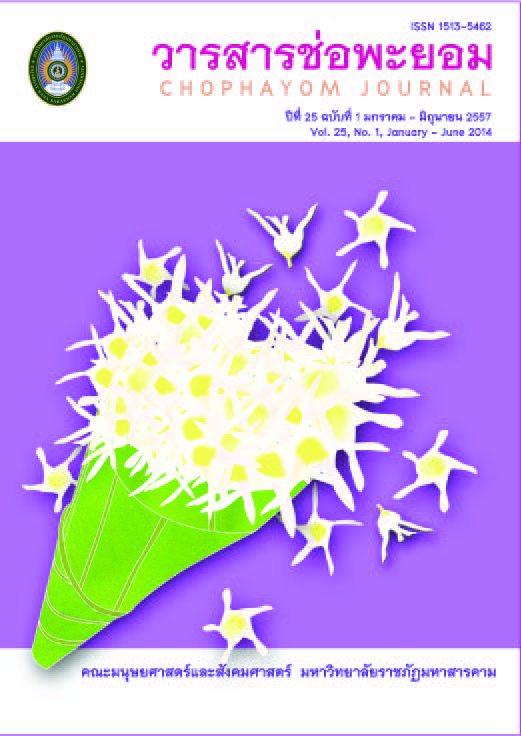รูปแบบการพัฒนาการดำเนินงานกลุ่มวิสาหกิจชุมชนในอำเภอร่องคำ จังหวัดกาฬสินธุ์ (The Operating Development Model of Community Enterprises in Rongkham District, Kalasin Province)
Abstract
บทคัดย่อ
การศึกษาครั้งนี้มีวัตถุประสงค์ดังนี้1) เพื่อศึกษาปัจจัยที่มีผลต่อการดำเนินงานกลุ่มวิสาหกิจชุมชน 2) เพื่อสร้างรูปแบบการพัฒนาการดำเนินงานกลุ่มวิสาหกิจชุมชน และ 3) เพื่อทดลองและประเมินผลการใช้รูปแบบการพัฒนาการดำเนินงานกลุ่มวิสาหกิจชุมชน วิธีดำเนินการวิจัยแบ่งออกเป็น 3 ระยะคือ ระยะที่ 1 ศึกษาปัจจัยที่มีผลต่อการดำเนินงานกลุ่มวิสาหกิจชุมชน ประชากร คือ กลุ่มวิสาหกิจชุมชนในอำเภอร่องคำ จังหวัดกาฬสินธุ์ เลือกกลุ่มตัวอย่างเจาะจง ที่เป็นกรรมการกลุ่มวิสาหกิจชุมชน กลุ่มละ 5 คน 19 กลุ่ม เป็นจำนวน 95 คน เก็บรวบรวมข้อมูลซึ่งเป็นเครื่องมือแบบสอบถามกับกลุ่มตัวอย่าง การวิเคราะห์ข้อมูลโดยใช้โปรแกรมสถิติทางสังคมศาสตร์ สถิติที่ใช้ในการทดสอบสมมติฐาน ได้แก่ Multiple Linear Regression Analysis โดยใช้เทคนิคแบบหลายขั้นตอน (Stepwise) และวิเคราะห์สัมประสิทธิ์สหสัมพันธ์พหุคูณของเพียร์สัน (Pearson’s Multiple Correlation) ระยะที่ 2 สร้างรูปแบบการพัฒนาการดำเนินงานกลุ่มวิสาหกิจชุมชน นำรูปแบบการพัฒนาไปวิพากษ์โดยผู้เชี่ยวชาญ นักวิชาการ และผู้เกี่ยวข้องกับกลุ่มวิสาหกิจชุมชน จำนวน 30 คน ใช้การประชุมกลุ่มย่อย และระยะที่ 3 การทดลองใช้รูปแบบการพัฒนาการดำเนินงานของกลุ่มวิสาหกิจชุมชน คือ กลุ่มวิสาหกิจชุมชนระดับปรับปรุงตามเกณฑ์การประเมินจากกรมส่งเสริมการเกษตร ผลการศึกษาโดยสรุปมีดังนี้
1. ปัจจัยที่มีผลต่อการดำเนินงานกลุ่มวิสาหกิจชุมชน พบว่า ตัวแปรที่สามารถพยากรณ์ปัจจัยที่มีผลต่อการดำเนินงานกลุ่มวิสาหกิจชุมชน (Y) มีจำนวน 5 ตัวแปร เรียงลำดับอำนาจการพยากรณ์จากมากไปหาน้อย ได้แก่ ปัจจัยด้านการบริหารการเงิน (X8) ปัจจัยด้านการบริหารการผลิต (X6) ปัจจัยด้านการบริหารการตลาด (X7) ปัจจัยด้านผู้นำ (X1) และปัจจัยด้านการมีส่วนร่วมของสมาชิก (X5) แต่ละตัวแปรมีค่าสัมประสิทธิ์ของตัวพยากรณ์ในรูปคะแนนดิบ (b) เท่ากับ .180, .149, .232, .165 และ .224 ตามลำดับ ตัวพยากรณ์ในรูปคะแนนมาตรฐาน (B) เท่ากับ .203, .159, .220, .217 และ .234 ตามลำดับ และค่าสัมประสิทธิ์สหสัมพันธ์พหุคูณ (R) เท่ากับ .881 ค่าสัมประสิทธิ์การพยากรณ์ (R2) เท่ากับ .776อำนาจในการพยากรณ์ ร้อยละ 77.60 ค่าความคลาดเคลื่อนมาตรฐาน (SEest) เท่ากับ .301 และมีค่าคงที่ของสมการในรูปคะแนนดิบ (a) เท่ากับ .114 แสดงสมการในรูปคะแนนดิบ และสมการในรูปคะแนนมาตรฐาน ตามลำดับ ดังนี้
Y = .114 + .180 X8 + .149 X6 + .232 X7 + .165 X1 + .224 X5
Z = .203Z8 + .159Z6 + .220 Z7 + .217 Z1 + .234 Z5
2. ผลการสร้างรูปแบบการพัฒนาการดำเนินงานกลุ่มวิสาหกิจชุมชน เนื้อหาการพัฒนา ประกอบด้วย 5 ด้าน จำนวน 13 กิจกรรม คือ 1) ด้านการบริหารการเงิน จำนวน 3 กิจกรรม ได้แก่ (1) การฝึกอบรมการเงินการบัญชีเบื้องต้น (2) การฝึกปฏิบัติการจัดทำบัญชี (3) การให้คำปรึกษาเพื่อตอบปัญหา 2) ด้านการบริหารการผลิต จำนวน 2 กิจกรรม ได้แก่ (1) การฝึกอบรมการบริหารการผลิต (2) การทัศนศึกษาดูงานแลกเปลี่ยนเรียนรู้ 3) ด้านการบริหารการตลาด จำนวน 4 กิจกรรม ได้แก่ (1) การฝึกอบรมการบริหารการตลาด (2) การฝึกปฏิบัติการจัดทำแผนกลยุทธ์ทางการตลาด (3) การจัดทีมที่ปรึกษาประจำกลุ่ม (4) การจัดทัศนศึกษาดูงานแลกเปลี่ยนเรียนรู้ 4) ด้านผู้นำกลุ่ม จำนวน 1 กิจกรรม ได้แก่ การฝึกอบรมเพื่อพัฒนาผู้นำ และ 5) ด้านการมีส่วนร่วมของสมาชิก จำนวน 3 กิจกรรม ได้แก่ (1) การฝึกอบรมเกี่ยวกับการมีส่วนร่วม (2) การฝึกปฏิบัติโดยใช้เทคนิคการมีส่วนร่วมแบบ AIC และ (3) การจัดทีมที่ปรึกษาประจำกลุ่ม
3. ผลทดลองและประเมินการใช้รูปแบบการพัฒนาการดำเนินงานกลุ่มวิสาหกิจชุมชน พบว่า คณะกรรมการกลุ่มวิสาหกิจชุมชนมีความเห็นเกี่ยวกับผลสำเร็จในการดำเนินงานกลุ่มวิสาหกิจชุมชนดีขึ้นหลังจากการได้รับการพัฒนา ทั้งโดยรวมและรายด้านอย่างมีนัยสำคัญทางสถิติที่ระดับ .05 (p-value < .05) ซึ่งเป็นไปตามสมมติฐานที่ตั้งไว้
คำสำคัญ : กลุ่มวิสาหกิจชุมชน, การพัฒนารูปแบบดำเนินงาน
Abstract
The objectives of this thesis were 1) to study the influent factors to the operating performance of community enterprises, 2) to build the operating development model of the community enterprises, and 3) test and evaluate the usage of the operating development model of the community enterprises. The research methodology was divided into 3 phases. The first phase was the study of the influent factors to the operating performance of community enterprises in Rongkham district, Kalasin province. The population was 19 groups which each group comprised of a group of 5 community enterprises in Rongkham district. Data were collected by using the questionnaire with the sample groups and then analyzed by using Pearson Correlation Coefficient, and Multiple Regression Analysis (Stepwise). The second phase focused on building the operating development model of the community enterprises. The researchers brought the development model to be discussed in small groups with experts, scholars, and related people with the total of 30 people. In addition, the third phase aimed to test and evaluate the use of the operating development model of community enterprise that was in the remodel level by using MANOVA and Wilcoxon Sign Rank Test. According to the study, the results showed that;
1. the influent factors to the operating performance of the community enterprises (Y) had 5 variables numbering from maximum to minimum as follows: the financial management factors (X8), the production management factor(X6), the marketing management factor (X7), the leadership factor (X1) and the member participation factor (X3). Each variable had the coefficient value of the predictor results in the raw scores (b) as follows.180, .149, .232, .165, and .224. The predictor results in the standard scores (B) were calculated as follows .203, .159, .220, .217, and .234. The multiple correlation coefficient (R) equaled to .881. The coefficient prediction (R2) equaled to .776. The predictive power was at 77.6 percent. The standard deviation (SEest) equaled to .301. Constants of the equation in the form of raw scores (a) equaled to .114. The researchers were able to present the equation in the raw scores and equations in the standard scores as the followings:
Y = .114+.180X8 + .149X6 + .232X7 + .165X1 + .224X3
Z = .203Z8 + .159Z6 + .220Z7 + .217Z1 + .234Z3
2. the results in building the operating development model of community enterprise consisted of 5 main aspects and 13 activities from those aspects: The first factor was financial management which contained 3 activities: the training of the basic finance and accounting, the workshop of the accounting work, and the advisory service, The second factor was the production management: the training of the production management and the field trips for learning. There were 4 activities of the marketing management factor such as the training of the marketing management, the workshop of the marketing strategy planning, arranging the advisor for each group, and the field trips for learning. The training for developing the leader was an activity of the group leadership factor. The last factor was member participation which had 3 activities: the training for the participation, the workshop by using the AIC participation technique, and arranging the advisor for each group.
3. the test results and the evaluation of using the operating development model of community enterprise indicated that the operation performance of the community enterprise had better success results after being developed with the statistical significant level at .05 (p-value < .05), which followed the determined hypothesis.
Keyword: Community Enterprise, The Operating Developsment Model






